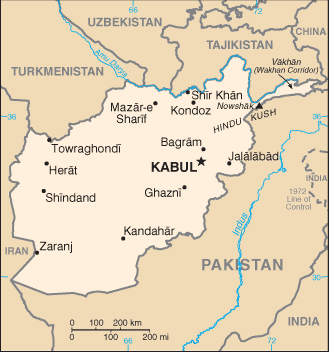Airspace: 250,000 square miles
Recent Airspace Conflicts
In 1994 the U.S. Federal Aviation Association issued a Special Federal Aviation Regulation that prohibited American aviators from flying within the territorial airspace of Afghanistan. In the regulation, it was explained that certain factions in the ongoing Afghan civil war had intentionally targeted civil aircraft. The regulation was extended each year through 2000.
On September 16, 2001, the Taliban shut down Afghanistan’s airspace. The estimated 120 daily flights across Afghan airspace were redirected south of the Himalayas toward India. This is an expensive measure for airlines due to fuel and additional travel time.
Shortly before the attacks on the United States on September 11th, the Taliban in Afghanistan had warned that they might shut down the airspace if U.N. sanctions against Afghanistan were not lifted. Sanctions had initially been imposed due to the Taliban’s harboring of Al-Qaeda operatives following the Al-Qaeda bombings of the U.S. embassies in 1998.
The U.S.-led invasion of Afghanistan started in October 2001, in the wake of the September 11, 2001, attacks on the United States. The invasion marked the beginning of the U.S. “War on Terror” campaign, seeking to oust the Taliban and capture al-Qaeda leader Osama bin Laden. In February 2002, the American Combined Forces Air Component Commander took control of the Airspace Control Authority for Afghanistan, effectively taking responsibility for Afghan airspace.
Under the oversight of the the Ministry of Transport in Afghanistan, the Kabul Air Control Center took the reigns of Afghan high-altitude airspace on May 15, 2005, and with it the responsibility of handling all flights over Afghan territory. Afghanistan gained control over low-altitude airspace on July 11, 2005.
Airspace Regulatory Body
The Kabul Air Control Center officially opened on July 12, 2005, in a ceremony that was presided over by the second vice president of Afghanistan Karim Khalili. By July 15th, the Kabul Air Control Center controlled airspace at high-level altitude, which handles commercial, civilian and cargo aircraft, and low-level altitude, which services a mixture of civil and military aircraft. The air routes over Afghanistan are the shortest distances between Asia and Europe. Each flight that passes over Afghanistan generates hundreds of dollars of revenue for the Afghan government to use in improving infrastructure and promoting the establishment of a comprehensive aviation structure for Afghanistan.
Membership in International Aviation Organizations
International Civil Aviation Organization (ICAO): The ICAO works to establish international standards regarding technical aspects of aviation. After the ICAO adopts a standard, it is put into effect by each ICAO member nation in its own territories.
Sources: ASSOCIATED PRESS, FREQUENT FLIER MAGAZINE,
Regional Air Movement Control Center, Ministry of Finance Afghanistan, Federal Aviation Administration, International Civil Aviation Organization
- Previous: Introduction
- Next: Albania



